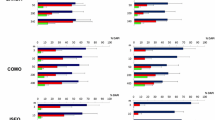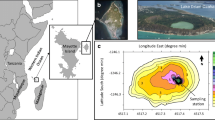Abstract
Species diversity and richness, and seasonal population dynamics of phytoplankton, planktonic protozoa, and bacterioplankton sampled from the epilimnion of Crystal Bog in 2000, were examined in order to test the hypothesis that these groups’ diversity and abundance patterns might be linked. Crystal Bog, a humic lake in Vilas County, Wisconsin, is part of the North Temperate Lakes Long-Term Ecological Research Site. Phytoplankton and planktonic protozoa were identified and enumerated in a settling chamber with an inverted microscope. Bacterial cells were enumerated with the use of fluorescence 4′, 6′-diamidino-2-phenylindole (DAPI)-staining procedures, and automated ribosomal intergenic spacer analysis (ARISA) was used to assess bacterioplankton diversity. Bacterial cell counts showed little seasonal variation and averaged 2.6 × 106 cells/mL over the ice-free season. Phytoplankton and planktonic protozoan numbers varied by up to two orders of magnitude and were most numerous in late spring and summer. Dinoflagellates largely dominated Crystal Bog throughout the ice-free period, specifically Peridiniopsis quadridens in the spring, Peridinium limbatum in summer, and Gymnodinium fuscum and P. quadridens in fall. Brief blooms of Cryptomonas, Dinobryon, and Synura occurred between periods of dinoflagellate domination. The dominant dinoflagellate, Peridinium limbatum, was calculated to have a growth rate of 0.065 day−1 and a doubling time of 10.7 days. Heterotrophic nanoflagellates (HNFs) were a consistent component of the planktonic protozoa; seasonal patterns were determined for three genera of HNFs (Monosiga, Bicosoeca, and Desmarella moniliformis). Three genera of ciliates (Coleps, Strobilidium, and Strombidium) comprised the greater part of the planktonic protozoa in Crystal Bog. The number of species of planktonic protozoa was too low to calculate a diversity index. Shannon–Weaver diversity indices for phytoplankton and bacterioplankton in the epilimnion followed very similar seasonal patterns in this lake, supporting the hypothesis that in freshwaters, diversity patterns of these groups are linked.












Similar content being viewed by others
References
C Amblard J-F Carrias G Bourdier N Maurin (1994) ArticleTitleThe microbial loop in a humic lake: seasonal and vertical variations in the structure of the different communities. Hydrobiologia 300/301 71–84 Occurrence Handle10.1007/BF00024449
L Arvola K Salonen (2001) ArticleTitlePlankton community of a polyhumic lake with and without Daphnia longispina (Cladocera). Hydrobiologia 445 141–150 Occurrence Handle10.1023/A:1017588913646
JR Beaver TL Crisman (1989) ArticleTitleAnalysis of the community structure of planktonic ciliated protozoa relative to trophic state in Florida lakes. Hydrobiologia 174 177–184 Occurrence Handle1:CAS:528:DyaL1MXmtFyqsLg%3D
P Bourrelly (1968) Les Algues d’Eau Douce Tome II Les Algues Jaunes et Brunes Éditions N Boubée & Cie Paris
JM Burkholder HB Glasgow Jr CW Hobbs (1995) ArticleTitleFish kills linked to a toxic ambush-predator dinoflagellate: distribution and environmental conditions. Mar Ecol Prog Ser 124 43–61
KL Cottingham SR Carpenter AL St. Amand (1998) ArticleTitleResponses of epilimnetic phytoplankton to experimental nutrient enrichment in three small seepage lakes. J Plankton Res 20 1889–1914
HT Croasdale CE deM Bicudo GW Prescott (1983) A Synopsis of North American Desmids, Part II, Section 5 University of Nebraska Press Lincoln, NE
MM Fisher EW Triplett (1999) ArticleTitleAutomated approach for ribosomal intergenic spacer analysis of microbial diversity and its application to freshwater bacterial communities. Appl Environ Microbiol 65 4630–4636
MM Fisher JL Klug GH Lauster M Newton EW Triplett (2000) ArticleTitleEffects of resources and trophic interactions on freshwater bacterioplankton diversity. Microb Ecol 40 125–138 Occurrence Handle1:CAS:528:DC%2BD3cXotFCqs7w%3D Occurrence Handle11029081
W Foissner H Berger (1996) ArticleTitleA user-friendly guide to the ciliates (Protozoa, Ciliophora) commonly used by hydrobiologists as bioindicators in rivers, lakes, and waste waters, with notes on their ecology. Freshwat Biol 35 375–482
Foissner, W, Blatterer, H, Berger, H, Kohmann, F (1991) Taxonomische and ökologische Revision der Ciliaten des Saprobiensystems — Band I: Cyrtophorida, Oligotrichida, Hypotrichida, Colpodea. Informationsberichte des Bayerischen Landesamtes für Wasserwirtschaft 1:1–478
TM Frost JP Descy BT DeStasio GA Gerrish JM Hood JP Hurley AL St. Amand (2000) ArticleTitleEvaluations of phytoplankton communities using varied techniques: a multi-media comparison of lakes in northern Wisconsin USA. Verh Internat Verein Limnol 27 1023–1030
SI Heaney (1976) ArticleTitleTemporal and spatial distribution of the dinoflagellates Ceratium hirundinella OF Muller within a small productive lake. Freshwat Biol 6 531–542
H Hillebrand CD Durselen D Kirschtel U Pollinger T Zohary (1999) ArticleTitleBiovolume calculation for pelagic and benthic microalgae. J Phycol 35 403–424 Occurrence Handle10.1046/j.1529-8817.1999.3520403.x
WD Hiorns BA Methé SA Nierzwicki-Bauer JP Zehr (1997) ArticleTitleBacterial diversity in Adirondack mountain lakes as revealed by 16S rRNA gene sequences. Appl Environ Microbiol 63 2957–2960 Occurrence Handle1:CAS:528:DyaK2sXktlersL4%3D Occurrence Handle9212443
MG Höfle H Haas K Dominik (1999) ArticleTitleSeasonal dynamics of bacterioplankton community structure in a eutrophic lake as determined by 5S rRNA analysis. Appl Environ Microbiol 65 3164–3174
JB Hughes JJ Hellmann TH Ricketts BJM Bohannan (2001) ArticleTitleCounting the uncountable: statistical approaches to estimating microbial diversity. Appl Environ Microbiol 67 4399–4406 Occurrence Handle10.1128/AEM.67.10.4399-4406.2001 Occurrence Handle1:CAS:528:DC%2BD3MXns1Wisro%3D Occurrence Handle11571135
M Jansson P Blomqvist A Jonsson A-K Bergström (1996) ArticleTitleNutrient limitation of bacterioplankton, autotrophic and mixotrophic phytoplankton, and heterotrophic nanoflagellates in Lake Örträsket. Limnol Oceanogr 41 1552–1559
K Jurgens (1953) ArticleTitleThe red tide of Lake Austin, Texas. Game Fish 2 8
K Kalinowska (2000) ArticleTitleCiliates in small humic lakes (Masurian Lakeland, Poland): relationship to acidity and trophic parameters. Pol J Ecol 48 169–183
RR Kudo (1971) Protozoology Charles C. Thomas Springfield, IL
ES Lindström (2000) ArticleTitleBacterioplankton community composition in five lakes differing in trophic status and humic content. Microb Ecol 40 104–113 Occurrence Handle1:CAS:528:DC%2BD3cXotFCqs78%3D Occurrence Handle11029079
J Marty B Pinel-Alloul JF Carrias (2002) ArticleTitleEffect de la predation et des nutriments sur les reseaux microbiens planctoniques. Revue Sci de 1’Eau 15 37–49
DJ Patterson (1998) Free-Living Freshwater Protozoa John Wiley & Sons New York
EC Pielou (1977) Mathematical Ecology John Wiley & Sons New York
U Pollinger (1988) Freshwater armored dinoflagellates: growth, reproduction strategies, and population dynamics. CD Sandgren (Eds) Growth and Reproductive Strategies of Freshwater Phytoplankton Cambridge University Press Cambridge, UK 134–174
U Pollinger (1981) ArticleTitleThe structure and dynamics of the phytoplankton assemblages in Lake Kinneret, Israel. J Plankton Res 3 93–105
KG Porter YS Feig (1980) ArticleTitleThe use of DAPI for identifying and counting aquatic microflora. Limnol Oceanogr 25 943–948
J Popovsky LA Pfiester (1990) Subwasserflora von Mitteleuropa, Band 6, Dinophyceae (Dinoflagellida) Gustav Fischer Verlag Jena
GW Prescott (1951) Algae of the Western Great Lakes Area Cranbrook Institute of Science Bloomfield Hills, MI
GW Prescott HT Croasdale WC Vinyard (1975) A Synopsis of North American Desmids Part II, Section 1 University of Nebraska Press Lincoln, NE
GW Prescott HT Croasdale WC Vinyard (1977) A Synopsis of North American Desmids Part II, Section 2 University of Nebraska Press Lincoln, NE
GW Prescott HT Croasdale WC Vinyard CE deM Bicudo (1981) A Synopsis of North American Desmids Part II, Section 3 University of Nebraska Press Lincoln, NE
GW Prescott CE deM Bicudo WC Vinyard (1982) A Synopsis of North American Desmids Part II, Section 4 University of Nebraska Press Lincoln, NE
K Rengefors C Legrand (2001) ArticleTitleToxicity in Peridinium aciculiferum — an adaptive strategy to outcompete other winter phytoplankton. Limnol Oceanogr 46 1990–1997 Occurrence Handle1:CAS:528:DC%2BD38Xht12lsw%3D%3D
N Revelante M Gilmartin (1982) ArticleTitleDynamics of phytoplankton in the Great Barrier Reef Lagoon. J Plankton Res 4 47–76
S Romo MR Miracle (1995) ArticleTitleDiversity of the phytoplankton assemblages of a polymictic hypertrophic lake. Arch Hydrobiol 132 363–384
RW Sanders KG Porter (1988) Phagotrophic phytoflagellates. KC Marshall (Eds) Advances in Microbial Ecology Plenum New York 167–192
GM Smith (1950) The Fresh-Water Algae of the United States McGraw-Hill New York
U Sommer (1993) ArticleTitlePhytoplankton competition in Plußsee: a field test of the resource-ratio hypothesis. Limnol Oceanogr 38 838–845 Occurrence Handle1:CAS:528:DyaK2cXit1GqtLY%3D
DK Stoecker (1999) ArticleTitleMixotrophy among dinoflagellates. J Eukaryot Microbiol 46 397–401
EJ Van Hannen G Zwart MP Van Agterveld HJ Gons J Ebert HJ Laanbroek (1999) ArticleTitleChanges in bacterial and eukaryotic community structure after mass lysis of filamentous cyanobacteria associated with viruses. Appl Environ Microbiol 65 795–801
SB Watson E McCauley JA Downing (1997) ArticleTitlePatterns in phytoplankton taxonomic composition across temperate lakes of differing nutrient status. Limnol Oceanogr 42 487–495
RG Wetzel (2001) Limnology Academic Press San Diego
RG Wetzel GE Likens (1991) Limnological Analyses Springer-Verlag New York
MG Wise JV McArthur LJ Shimkets (1997) ArticleTitleBacterial diversity of a Carolina bay as determined by 16S rRNA gene analysis: confirmation of novel taxa. Appl Environ Microbiol 63 1505–1514 Occurrence Handle1:CAS:528:DyaK2sXisVWrtLk%3D Occurrence Handle9097448
WJ Woelkerling (1976) ArticleTitleWisconsin desmids I, Aufwuchs and plankton communities of selected acid bogs, alkaline bogs, and closed bogs. Hydrobiologia 48 209–232 Occurrence Handle10.1007/BF00028693
J-T Wu L-L Kuo-Huang J Lee (1998) ArticleTitleAlgicidal effect of Peridinium bipes on Microcystis aeruginosa. Curr Microbiol 37 257–261 Occurrence Handle10.1007/s002849900375 Occurrence Handle1:CAS:528:DyaK1cXmt1agtrc%3D Occurrence Handle9732533
AC Yannarell AD Kent GH Lauster TK Kratz EW Triplett (2003) ArticleTitleTemporal patterns in bacterial communities in three temperate lakes of different trophic status. Microb Ecol 46 391–405 Occurrence Handle10.1007/s00248-003-1008-9 Occurrence Handle1:STN:280:DC%2BD2c%2FitlKgsA%3D%3D Occurrence Handle12904915
Acknowledgment
The authors acknowledge the support of the National Science Foundation under grant number MCB-9977903 through the Microbial Observatory Program. The authors also thank Tim Kratz for support at the field sites and LTER data.
Author information
Authors and Affiliations
Corresponding author
Rights and permissions
About this article
Cite this article
Graham, J., Kent, A., Lauster, G. et al. Seasonal Dynamics of Phytoplankton and Planktonic Protozoan Communities in a Northern Temperate Humic Lake: Diversity in a Dinoflagellate Dominated System. Microb Ecol 48, 528–540 (2004). https://doi.org/10.1007/s00248-004-0223-3
Received:
Accepted:
Published:
Issue Date:
DOI: https://doi.org/10.1007/s00248-004-0223-3




